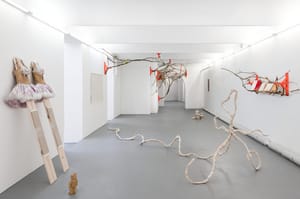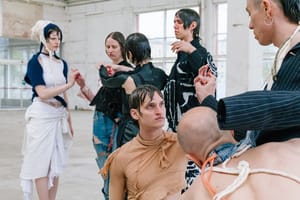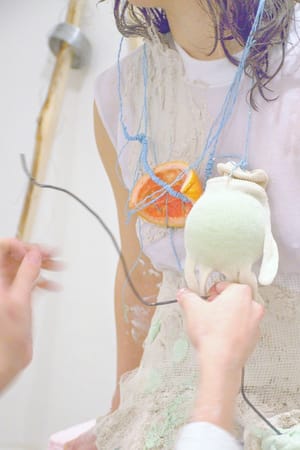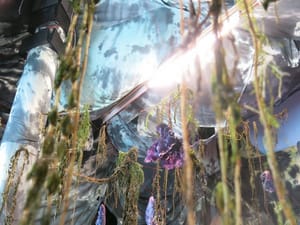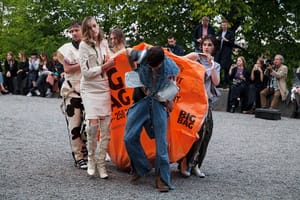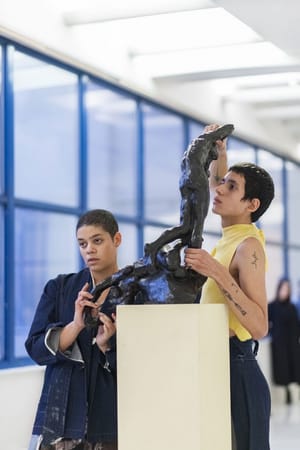- First Name
- Lukáš
- Surname
- Hofmann
- Other names - aliases
- Saliva
- Born
- 1993
- Birth place
- Praha
- Place of work
- Praha
- Website
- http://www.lukashofmann.net
- CSU Library
- ↳ Find in the catalogue
About artist
Lukáš Hofmann is known for the many different activities that come together organically in his work, namely artist, curator, stylist, and model. These “professions” incompletely frame his creative activities spanning many activities. The common denominator of these activities is fluidity and overlap. For Hofmann the contemporary world is the territory of a new and complex mythology that includes the field of commercial and alternative culture, technology and politics. However, this cannot be viewed as a stable territory, but more as a forever transforming map. His self-confident work therefore makes no distinction between art, fashion, everyday life and the reflections of these activities that appear on social networks.
Hofmann is a nomad between continents, art forms and people. His moniker Saliva makes reference to the circulation of corporeality, either in the form of the movement of bodies and excretion of bodily fluids like sweat and saliva, or in the form of the sharing of thoughts, emotions and experiences. However, corporeality has a fundamentally collective character in his work. In the choreography of his performances, actors move and gesticulate in mutual support, and, within a heightened sensitivity to the other, the collective body becomes a forever changing internal prosthesis, not only in relation to itself, but also to the things around. The themes of alienation and injury that reappear in art history to a varying degree of intensity here find an answer or absolution in the form of performative mutuality as a healing process.
Understanding community as a metaphor of the organism is not new. However, it is at present absolutely essential. We must react to the ways that technocratic society alienates us from ourselves while forcing us to accept personal responsibility for such a strategy by creating new approaches to mutuality and interpersonal relationships based on care and kindness. To this end Saliva mixes revisionism with the possibilities offered by the present and speculations regarding the future. It is for this reason that he places such an emphasis on documenting his performances and on social networking. At the same time, by means of performativity, objects and materials he makes reference to the internal experience and cultural epochs associated with it (e.g. in Sospiri from 2018 there is a reference to the Middle Ages). Hofmann works with a range of creative anachronisms. As well as the spatial and temporal level, his work can be seen as an intellectual map of references to a multiplicity of influences and inspirations. In his approach to life, which, following in the footsteps of the avant-garde or Fluxus movement, becomes an artwork in itself, Hofmann discovers a sensitive synthesis of technology, spirituality and ritual practice.
A personal encounter with Hofmann’s performances leaves us with the impression of condensed time and an intense slowness in which each performative gesture is not simply a note but a melody, and in which this collective action can be perceived as a polyphony of corporealities and emotionalities. Gestures such as mouth-to-mouth breathing, carrying the other, the creation of chains from fingers, aural manifestations etc. are layered, repeated, and patiently insist on their own incarnation. Though individual tasks are planned in advance, they are more or less improvised within the context of the performance itself.
An emphasis on the stylisation of the performers’ expression and appearance is important. Since we live in an age in which stylisation and authenticity cannot be separated out, Hofmann uses these simple gestures within a fashionable and stylised environment and thus draws attention to both their importance and their inadequacy. The immediacy that this achieves is also due to the fact that new arrivals are welcomed into the performance in a natural, non-violent way. The boundary between the artist and the viewer is clearly delineated, but the performance itself is forever being recreated.
Hofmann’s internet activities, travel and global networking give rise to an interest in contemporary human being as a holistic set of physical, technological and emotional strata that are constantly regrouping and reshaping as a consequence of the rapid reception of perceptions. Fashion and styling too, which represent pivotal means of expression in his work, function as another layer of corporeality, a reflection of mood and opinion. Clothing is a technological prosthesis like any other. It is the at the interface of the outcomes of reflections upon every experience and the world of the person wearing it. The way that Hofmann works with clothes is therefore very important. Sometimes this means articles of clothing from a second-hand shop stitched together. Other times it involves collaborations with fashion designers whose thinking about design goes beyond the conventional.
However, his clothes are often characterised by an error in the manufacturing process, a deliberate lack of individual parts, a tear or re-stitching, an oversized and unisex aesthetic. This work with materials reflects what is going on in human consciousness itself. The feeling that in the discourse of post-industrial production and the consumerism of global capitalism we are an exercise book according to instructions set forth elsewhere, and at the same time the desire contained within this cyclical process to attain our own authentic subjectivity, leads in Hofmann’s work to the search for new ways of defining ourselves in opposition to the hyperreal.
Lukáš Hofmann is known for the many different activities that come together organically in his work, namely artist, curator, stylist, and model. These “professions” incompletely frame his creative activities spanning many activities. The common denominator of these activities is fluidity and overlap. For Hofmann the contemporary world is the territory of a new and complex mythology that includes the field of commercial and alternative culture, technology and politics. However, this cannot be viewed as a stable territory, but more as a forever transforming map. His self-confident work therefore makes no distinction between art, fashion, everyday life and the reflections of these activities that appear on social networks.
Hofmann is a nomad between continents, art forms and people. His moniker Saliva makes reference to the circulation of corporeality, either in the form of the movement of bodies and excretion of bodily fluids like sweat and saliva, or in the form of the sharing of thoughts, emotions and experiences. However, corporeality has a fundamentally collective character in his work. In the choreography of his performances, actors move and gesticulate in mutual support, and, within a heightened sensitivity to the other, the collective body becomes a forever changing internal prosthesis, not only in relation to itself, but also to the things around. The themes of alienation and injury that reappear in art history to a varying degree of intensity here find an answer or absolution in the form of performative mutuality as a healing process.
Understanding community as a metaphor of the organism is not new. However, it is at present absolutely essential. We must react to the ways that technocratic society alienates us from ourselves while forcing us to accept personal responsibility for such a strategy by creating new approaches to mutuality and interpersonal relationships based on care and kindness. To this end Saliva mixes revisionism with the possibilities offered by the present and speculations regarding the future. It is for this reason that he places such an emphasis on documenting his performances and on social networking. At the same time, by means of performativity, objects and materials he makes reference to the internal experience and cultural epochs associated with it (e.g. in Sospiri from 2018 there is a reference to the Middle Ages). Hofmann works with a range of creative anachronisms. As well as the spatial and temporal level, his work can be seen as an intellectual map of references to a multiplicity of influences and inspirations. In his approach to life, which, following in the footsteps of the avant-garde or Fluxus movement, becomes an artwork in itself, Hofmann discovers a sensitive synthesis of technology, spirituality and ritual practice.
A personal encounter with Hofmann’s performances leaves us with the impression of condensed time and an intense slowness in which each performative gesture is not simply a note but a melody, and in which this collective action can be perceived as a polyphony of corporealities and emotionalities. Gestures such as mouth-to-mouth breathing, carrying the other, the creation of chains from fingers, aural manifestations etc. are layered, repeated, and patiently insist on their own incarnation. Though individual tasks are planned in advance, they are more or less improvised within the context of the performance itself.
An emphasis on the stylisation of the performers’ expression and appearance is important. Since we live in an age in which stylisation and authenticity cannot be separated out, Hofmann uses these simple gestures within a fashionable and stylised environment and thus draws attention to both their importance and their inadequacy. The immediacy that this achieves is also due to the fact that new arrivals are welcomed into the performance in a natural, non-violent way. The boundary between the artist and the viewer is clearly delineated, but the performance itself is forever being recreated.
Hofmann’s internet activities, travel and global networking give rise to an interest in contemporary human being as a holistic set of physical, technological and emotional strata that are constantly regrouping and reshaping as a consequence of the rapid reception of perceptions. Fashion and styling too, which reLukáš Hofmann is known for the many different activities that come together organically in his work, namely artist, curator, stylist, and model. These “professions” incompletely frame his creative activities spanning many activities. The common denominator of these activities is fluidity and overlap. For Hofmann the contemporary world is the territory of a new and complex mythology that includes the field of commercial and alternative culture, technology and politics. However, this cannot be viewed as a stable territory, but more as a forever transforming map. His self-confident work therefore makes no distinction between art, fashion, everyday life and the reflections of these activities that appear on social networks.
Hofmann is a nomad between continents, art forms and people. His moniker Saliva makes reference to the circulation of corporeality, either in the form of the movement of bodies and excretion of bodily fluids like sweat and saliva, or in the form of the sharing of thoughts, emotions and experiences. However, corporeality has a fundamentally collective character in his work. In the choreography of his performances, actors move and gesticulate in mutual support, and, within a heightened sensitivity to the other, the collective body becomes a forever changing internal prosthesis, not only in relation to itself, but also to the things around. The themes of alienation and injury that reappear in art history to a varying degree of intensity here find an answer or absolution in the form of performative mutuality as a healing process.
Understanding community as a metaphor of the organism is not new. However, it is at present absolutely essential. We must react to the ways that technocratic society alienates us from ourselves while forcing us to accept personal responsibility for such a strategy by creating new approaches to mutuality and interpersonal relationships based on care and kindness. To this end Saliva mixes revisionism with the possibilities offered by the present and speculations regarding the future. It is for this reason that he places such an emphasis on documenting his performances and on social networking. At the same time, by means of performativity, objects and materials he makes reference to the internal experience and cultural epochs associated with it (e.g. in Sospiri from 2018 there is a reference to the Middle Ages). Hofmann works with a range of creative anachronisms. As well as the spatial and temporal level, his work can be seen as an intellectual map of references to a multiplicity of influences and inspirations. In his approach to life, which, following in the footsteps of the avant-garde or Fluxus movement, becomes an artwork in itself, Hofmann discovers a sensitive synthesis of technology, spirituality and ritual practice.
A personal encounter with Hofmann’s performances leaves us with the impression of condensed time and an intense slowness in which each performative gesture is not simply a note but a melody, and in which this collective action can be perceived as a polyphony of corporealities and emotionalities. Gestures such as mouth-to-mouth breathing, carrying the other, the creation of chains from fingers, aural manifestations etc. are layered, repeated, and patiently insist on their own incarnation. Though individual tasks are planned in advance, they are more or less improvised within the context of the performance itself.
An emphasis on the stylisation of the performers’ expression and appearance is important. Since we live in an age in which stylisation and authenticity cannot be separated out, Hofmann uses these simple gestures within a fashionable and stylised environment and thus draws attention to both their importance and their inadequacy. The immediacy that this achieves is also due to the fact that new arrivals are welcomed into the performance in a natural, non-violent way. The boundary between the artist and the viewer is clearly delineated, but the performance itself is forever being recreated.
Hofmann’s internet activities, travel and global networking give rise to an interest in contemporary human being as a holistic set of physical, technological and emotional strata that are constantly regrouping and reshaping as a consequence of the rapid reception of perceptions. Fashion and styling too, which represent pivotal means of expression in his work, function as another layer of corporeality, a reflection of mood and opinion. Clothing is a technological prosthesis like any other. It is the at the interface of the outcomes of reflections upon every experience and the world of the person wearing it. The way that Hofmann works with clothes is therefore very important. Sometimes this means articles of clothing from a second-hand shop stitched together. Other times it involves collaborations with fashion designers whose thinking about design goes beyond the conventional.
However, his clothes are often characterised by an error in the manufacturing process, a deliberate lack of individual parts, a tear or re-stitching, an oversized and unisex aesthetic. This work with materials reflects what is going on in human consciousness itself. The feeling that in the discourse of post-industrial production and the consumerism of global capitalism we are an exercise book according to instructions set forth elsewhere, and at the same time the desire contained within this cyclical process to attain our own authentic subjectivity, leads in Hofmann’s work to the search for new ways of defining ourselves in opposition to the hyperreal.present pivotal means of expression in his work, function as another layer of corporeality, a reflection of mood and opinion. Clothing is a technological prosthesis like any other. It is the at the interface of the outcomes of reflections upon every experience and the world of the person wearing it. The way that Hofmann works with clothes is therefore very important. Sometimes this means articles of clothing from a second-hand shop stitched together. Other times it involves collaborations with fashion designers whose thinking about design goes beyond the conventional.
However, his clothes are often characterised by an error in the manufacturing process, a deliberate lack of individual parts, a tear or re-stitching, an oversized and unisex aesthetic. This work with materials reflects what is going on in human consciousness itself. The feeling that in the discourse of post-industrial production and the consumerism of global capitalism we are an exercise book according to instructions set forth elsewhere, and at the same time the desire contained within this cyclical process to attain our own authentic subjectivity, leads in Hofmann’s work to the search for new ways of defining ourselves in opposition to the hyperreal.
- Author of the annotation
- František Fekete
- Published
- 2019
CV
studium: 2019
Korean National University of Arts, Seoul 2016
UMPRUM Praha, Ateliér Sochařství Dominika Langa a Edith Jeřábkové 2014–2019
AVU Praha, Ateliér Intermédia III Tomáše Vaňka
2012–2014
ČVUT Praha, Fakulta architektury
stáže: 2019
zahraniční stáž, Residency Unlimited, New York 2018
zahraniční stáž, Jupiter Wood Gallery, London 2017
Land art project, Sterna collaboration with Are, Nisyros Island 2016
zahraniční stáž, M.I Gallery, Berlín
ocenění: 2019
Laureát Ceny Jindřicha Chalupeckého 2018
zaměstnání / praxe: od 2020
Centrum pro současné umění FUTURA - kurátor
- Member of art groups not included in ARTLIST.
- Houba Studios
Exhibitions
- Solo exhibitions
-
2017
Enzyme, Galerie Frangulyan, Paříž
Frenzied Chirping 1 and 2, Daily Lazy and Pane Per Poveri festival, Atény
Dry me a river , PLATO Ostrava
2016
L'eau des Algues, Cabaret Voltaire, Curych
Big Bag, Moderna Museet, Stockholm
Houba Studios first exhibition, Creepy Teepee festival, Kutná Hora
Sew into Me, Kassandras, Atény
Classic Arrangement of Five Pure White Roses, Schinkel Pavillon, Berlín
There's no Place like Homes, M.I Gallery, Berlín
lkea Made Fashion, GAVU, Praha
2015
Unlimited Sportsforest Chicas, M.I Gallery, Berlín
We will suffocate, Studio Letná, Praha
Guerilla Photographic Darkroom (s Kateřinou Konvalinovou), AVU, Praha
- Group exhibitions not included in ARTLIST.
-
2018
Výstava finalistů Ceny Jindřicha Chalupeckého 2018, Národní galerie v Praze
Guiding Dog for a Blind Dog kurátorský projekt, galerie Futura, Praha
2017
Phantom Limb, SMK Danish National Gallery, Kodaň
2016
Against Nature, Národní galerie v Praze
What's that dirt under your nails made of?, kurátorský projekt, Karlín Studios, Praha
Ying Colloseum 9, Korner Park, Berlín
Production of too many useful things leads to production of too many useless people,Studio Galéria, Budapešť
Miera abstrakcie v konkrétnom živote klesá, Stredoslovenska galeria, Bánska Bystrica
Kase kaseova, byt na Tachovském náměstí, Praha
Dům módy, galerie Hraničář, Ústí nad Labem.
Bob the Builder, Berlínskej model, Praha
2015
Pokoje, Containall, Praha
Proč mluvit se zvířaty?, DEPO2015, Plzeň
2014
Litanie prekariátu, Berlínskej model, Praha
2013
So, who's the artist, Plevel, Praha
- Other realisations
2018
casting direction for prague fashion week 2017
anaerobic respiration workshop, autonomní sociální centrum Klinika, Praha
holly herndon vocal ensemble styling, Wiener festwoche, Vídeň 2016
ecocore narcissus publication contribution, Ecocore magazine
scene afterform publication contribution, Migros museum
laformela fashion show styling, Prague fashion week, Praha
Monography
- Articles
en: glamcult.com/ottolinger-fashions-lukas-hofmanns-moving-tale/footnotesonart.com/more.phpwww.sleek-mag.com/article/lukas-hofmann-saliva-intimacy/www.aqnb.com/2017/06/07/to-the-bottom-of-the-ocean-with-lukas-hofmannsaliva-in-enzyme-at-galerie-frangulyan/novembremagazine.com/big-bag-by-lukas-hofmann-saliva-nico-arauner-barbara-klawitterdismagazine.com/blog/83881/nils-lange-saliva-leau-des-algues/kubaparis.com/retrospective-by-artist-lukas-hofmann/www.nordicstylemag.com/2016/09/fwsthlm-amaze/ cz: https://artalk.cz/2019/07/04/lukas-hofmann-se-stava-novym-kuratorem-futura/artalk.cz/2018/05/24/lukas-hofmann-v-mem-svete-neexistuji-pevne-body/drive.google.com/file/d/0B5pcxskq13jJZUU4aXZRM1pyWERhN1cxNmg4ekJNNkV2dEJZ/viewartalk.cz/2018/05/15/prochazet-vystavou-jako-slepec-bez-vodiciho-psa/artalk.cz/2017/01/23/retrospektiva-jako-sebe-mytologizujici-performance/ de: i-d.vice.com/de/article/j5md3y/der-kunstler-lukas-hofmann-spielt-in-seine-performances-mit-emotionen (english translation: docs.google.com/document/d/1mkSqzJnZBXE2-Xdeco71OIYHWP9qFUcEcyr9vjDJ8MY/edit)


